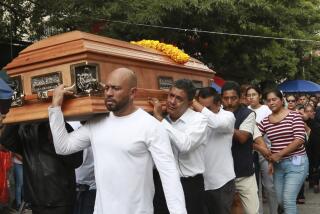Ortega, Rebel Leaders Admit to Mounting Toll
- Share via
MANAGUA, Nicaragua — President Daniel Ortega said Wednesday that U.S.-backed rebels killed 1,019 Sandinista soldiers in 1986 but suffered far higher losses in casualties and desertions from their own ranks.
In a year-end address, Ortega said his army’s advantage over the rebels helped the economy rebound from a 1985 slump, but he warned that the fighting will mean continued hardship for Nicaraguans.
The battlefield statistics offered by the president conflict with those of rebel leaders, though both sides admit steadily mounting losses in the five-year-old war.
Ortega said the conflict has cost more than 35,000 lives and $2.8 billion in lost production since 1981, two years after his leftist government came to power.
Heavier Fighting Seen
The fighting is expected to intensify in the months ahead as $100 million in new aid authorized in October by the U.S. Congress reaches the contras in the form of weapons and CIA-supervised training.
In 1986, Ortega said, Sandinista forces took the initiative in 90% of more than 3,000 clashes with the Honduras-based rebels inside Nicaragua. As a result, 4,000 contras were killed and 2,600 were wounded, he said, compared to 1,019 dead and 1,798 wounded in the Sandinista ranks.
Several hundred residents who gathered to hear Ortega speak in the working class neighborhood called 14th of September greeted his announcement of contra casualties with sustained applause.
The Sandinista casualty figures were disputed by Adela Icaza, a rebel spokeswoman in Tegucigalpa, Honduras. She said in a telephone interview that 2,247 Sandinista soldiers were killed and 3,159 were wounded in 866 clashes during the year. She did not detail rebel losses.
‘Terrorist Actions’
Adolfo Calero, civilian leader of the Nicaraguan Democratic Force, the largest anti-Sandinista army, said by telephone from Miami that the contras had fewer than 2,000 casualties last year including dead and wounded.
Ortega said that 1,100 civilians were killed or wounded in “terrorist actions” by the contras, but Calero insisted that the Sandinistas’ civilian casualties were for the most part militiamen and other armed people. Asked about civilian victims of mines, he repeated the contra position that they do not use mines.
In the most recent attack reported by the Defense Ministry, six civilians died before dawn last Friday when about 60 contras shelled their 17-family farming cooperative at Cana Brava in the south central department of Boaca.
Contras’ ‘Decomposition’
A central assertion of Ortega’s assessment was what he called the contras’ “decomposition.” He said their estimated strength of 11,000 fighters at the start of the war had dwindled to about 6,500.
Ortega said 1,500 men deserted the contra ranks inside Nicaragua in 1986 and surrendered their weapons. The Sandinistas captured another 1,400 rifles, 115 rocket launchers and 337 grenades in attacks on rebel positions, he said.
But Calero said: “You have to take the figures (Ortega) gives as favoring his side and multiply the Sandinista casualties by three. The figures he gives for our casualties you divide by three, and the figures he gives for our troop strength you multiply by three, and you will have the reality.”
Calero said that last year the Sandinistas put contra casualties for 1985 at 5,000, and added: “If what they say is true, that we had 5,000 last year and we have more than 6,000 this year (1986), and we still have 6,500 troops, then that just demonstrates that our human resources are inexhaustible. Without the need of a draft, we have volunteers who come into our ranks only to fight for democracy.”
100,000 Sandinistas
Not long ago a spokesman for the Nicaragua Democratic Force said it had 20,000 men, about half of them inside Nicaragua. Reagan Administration officials, who hope to build the rebel forces to 30,000 with the help of the new aid, estimate their current strength at 18,000, compared to the 100,000 Sandinista soldiers, reserves and militiamen.
On Wednesday, Ortega said: “The truth is, President Reagan, your policy has cost more than 35,000 victims. But in spite of that, your freedom fighters, your killers, your terrorists, your pistoleros are being defeated and will continue to be defeated.”
Ortega announced that Nicaragua’s economy, after shrinking 5% in 1985, had grown by 4.6%, thanks mostly to better coffee and sugar harvests in rural areas previously afflicted by contra attacks. He set a 2.1% growth target for 1987.
Wearing an army uniform, he spoke for 35 minutes from an outdoor basketball court. He was flanked by two militia brigades on one side and an army band on the other. Behind him sat crippled war veterans in wheelchairs and mothers of dead Sandinista soldiers.
‘Nobody Surrenders Here’
A banner overhanging the court spelled out the government’s theme for 1987: “Nobody surrenders here.” Ortega said its meaning was not only military. He said it also meant that urban wage earners must continue to put up with economic austerity dictated by the war effort.
“To fulfill the economic plan, to fulfill the defense plan, this year, 1987, will be a year of great sacrifice,” he said. “What this requires is discipline and more discipline.”
There was mild applause.
Ortega acknowledged that the war was not the only cause of Nicaragua’s economic difficulties and pledged “to combat with energy” wasteful government spending.
More to Read
Sign up for Essential California
The most important California stories and recommendations in your inbox every morning.
You may occasionally receive promotional content from the Los Angeles Times.













